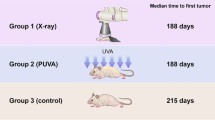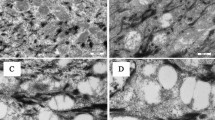Abstract
Over 1 million new cases of ultraviolet radiation-induced non-melanoma skin cancers (NMSC) per year now occur in the USA and the incidence of these diseases continues to increase. New preventative strategies are required. The hypothesis tested was that dietary administration of the putative cancer chemopreventatives sodium-copper-chlorophyllin (Chlor) or indole-3-carbinol (I3C) would inhibit UV-induced skin carcinogenesis in the Crl:SKH1:hr-BR hairless mouse. Groups of 20 mice were pre-fed isocaloric/isonutritive 20% corn-oil AIN-76a based diets that contained either Chlor (1.52 g%), I3C (5.08 g%) or no chemopreventative (control) for 2 weeks followed by exposure of their dorsal skin to a 10 week incremental, sub-erythemal, carcinogenic simulated solar UV exposure regime. Feeding was continued for the duration of the experiment. Matched non-UV exposed dietary groups were also included in the experimental design. The diets had no significant (p > 0.05) effect on body weight, feed consumption, cutaneous methanol-extractable UV photoprotective substances or on cutaneous UV-reflective characteristics. By day 180, UV-irradiated mice fed the Chlor had a significantly (p < 0.05) higher tumor multiplicity (33.6 ± 4.72; mean ± SEM) than UV-irradiated control animals (22.8 ± 4.25). UV-irradiated mice fed I3C had a significantly (p < 0.001) lower tumor multiplicity (13.0 ± 2.42) than that of both the UV-irradiated control and UV-irradiated Chlor-fed mice. The Chlor or I3C diets did not significantly (p > 0.05) affect UV-induced systemic suppression of contact hypersensitivity responses. These results demonstrate augmentation of the UV-induced cutaneous carcinogenic process by dietary chlorophyllin and protection from this carcinogenic process by indole-3-carbinol via mechanisms that do not involve changes in skin optical properties, modulation of photoimmunosuppression or caloric/nutrient effects.
Similar content being viewed by others
References
W. Y. Chung, et al, Inhibitory effects of chlorophyllin on 7,12-dimethylbenz[a]anthracene-induced bacterial mutagenesis and mouse skin carcinogenesis, Cancer Lett., 1999, 145(1-2), 57–64.
R. Dashwood, et al, Chemopreventive properties of chlorophylls towards aflatoxin B1: a review of the antimutagenicity and anticar-cinogenicity data in rainbow trout, Mutat. Res., 1998, 399(2), 245–53.
D. Guo, et al, Protection by chlorophyllin and indole-3-carbinol against 2-amino-1-methyl-6-phenylimidazo[4,5-b]pyridine (PhIP)-induced DNA adducts and colonic aberrant crypts in the F344 rat, Carcinogenesis, 1995, 16(12), 2931–7.
R. Hasegawa, et al, Inhibitory effect of chlorophyllin on PhIP-induced mammary carcinogenesis in female F344 rats, Carcinogenesis, 1995, 16(9), 2243–6.
J. Kim, et al, Anti-promotion effect of chlorophyllin in DMBA-TPA-induced mouse skin carcinogenesis, Anticancer Res., 2000, 20(3A), 1493–8.
K. K. Park and Y. J. Surh, Chemopreventive activity of chlorophyllin against mouse skin carcinogenesis by benzo[a]pyrene and benzo[a]pyrene-7,8-dihydrodiol-9,10-epoxide, Cancer Lett., 1996, 102(1-2), 143–9.
A. P. Reddy, et al, Inhibition of dibenzo[a,l]pyrene-induced multi-organ carcinogenesis by dietary chlorophyllin in rainbow trout, Carcinogenesis, 1999, 20(10), 1919–26.
A. Singh, S. P. Singh and R. Bamezai, Modulatory influence of chlorophyllin on the mouse skin papillomagenesis and xenobiotic detoxication system, Carcinogenesis, 1996, 17(7), 1459–63.
S. Sugie, et al, Inhibitory effect of chlorophyllin on diethylnitrosamine and phenobarbital-induced hepatocarcinogenesis in male F344 rats, Jpn. J. Cancer Res., 1996, 87(10), 1045–51.
K. K. Park, et al, Inhibitory effects of chlorophyllin, hemin and tetrakis(4-benzoic acid)porphyrin on oxidative DNA damage and mouse skin inflammation induced by 12-O-tetradecanoylphorbol-13-acetate as a possible anti-tumor promoting mechanism, Mutat. Res., 2003, 542(1-2), 89–97.
B. Srivastava and Y. Shukla, Antitumour promoting activity of indole-3-carbinol in mouse skin carcinogenesis, Cancer Lett., 1998, 134(1), 91–5.
M. Xu and R. H. Dashwood, Chemoprevention studies of heterocyclic amine-induced colon carcinogenesis, Cancer Lett., 1999, 143(2), 179–83.
Y. H. He, et al, Indole-3-carbinol as a chemopreventive agent in 2-amino-1-methyl-6-phenylimidazo[4,5-b]pyridine (PhIP) carcinogenesis: inhibition of PhIP-DNA adduct formation, acceleration of PhIP metabolism, and induction of cytochrome P450 in female F344 rats, Food Chem. Toxicol, 2000, 38(1), 15–23.
C. J. Grubbs, etal, Chemoprevention of chemically-induced mammary carcinogenesis by indole-3-carbinol, Anticancer Res., 1995, 15(3), 709–16.
N. Tachino, et al, Mechanisms of the in vitro antimutagenic action of chlorophyllin against benzo[a]pyrene: studies of enzyme inhibition, molecular complex formation and degradation of the ultimate carcinogen, Mutat. Res., 1994, 308(2), 191–203.
F. L. Chung, etal, Inhibition of tobacco-specific nitrosamine-induced lung tumorigenesis by compounds derived from cruciferous vegetables and green tea, Ann. N. Y. Acad. Sci., 1993, 686, 186–201; discussion 201-2.
G. S. Bailey, et al, Modulation of mycotoxin and nitrosamine carcinogenesis by indole-3-carbinol: quantitative analysis of inhibition versus promotion, IARC Sci. Publ, 1991, (105), 275–80.
J. Zhang, et al, Indole-3-carbinol induces a G1 cell cycle arrest and inhibits prostate-specific antigen production in human LNCaP prostate carcinoma cells, Cancer, 2003, 98(11), 2511–20.
X. Zhang and D. Malejka-Giganti, Effects of treatment of rats with indole-3-carbinol on apoptosis in the mammary gland and mammary adenocarcinomas, Anticancer Res, 2003, 23(3B), 2473–9.
G. L. Firestone and L. F. Bjeldanes, Indole-3-carbinol and 3-3’-diindolylmethane antiproliferative signaling pathways control cell-cycle gene transcription in human breast cancer cells by regulating promoter-Sp1 transcription factor interactions, J. Nutr., 2003, 133(7 Suppl), 2448S–2455S.
K. M. Rahman, O. Aranha and F. H. Sarkar, Indole-3-carbinol (I3C) induces apoptosis in tumorigenic but not in nontumorigenic breast epithelial cells, Nutr. Cancer, 2003, 45(1), 101–12.
M. Nachshon-Kedmi, et al, Indole-3-carbinol and 3,3’-diindolylmethane induce apoptosis in human prostate cancer cells, Food Chem. Toxicol, 2003, 41(6), 745–52.
L. M. Howells, et al, Indole-3-carbinol inhibits protein kinase B/Akt and induces apoptosis in the human breast tumor cell line MDA MB468 but not in the nontumorigenic HBL100 line, Mol Cancer Ther, 2002, 1(13), 1161–72.
D. Z. Chen, et al, Indole-3-carbinol and diindolylmethane induce apoptosis of human cervical cancer cells and in murine HPV16-transgenic preneoplastic cervical epithelium, J. Nutr, 2001, 131(12), 3294–302.
R. B. Cope, et al, Dietary butter protects against ultraviolet radiation-induced suppression of contact hypersensitivity in Skh:HR-1 hairless mice, J. Nutr, 1996, 126(3), 681–92.
R. B. Cope, et al, Exposure to soil contaminated with an environmental PCB/PCDD/PCDF mixture modulates ultraviolet radiation-induced non-melanoma skin carcinogenesis in the Crl:SKH1:hr-BR hairless mouse, Cancer Lett., 2003, 191(2), 145–54.
R. B. Cope, et al, Resistance of a lizard (the green anole, Anolis carolinensis; Polychridae) to ultraviolet radiation-induced immunosuppression, Photochem. Photobiol, 2001, 74(1), 46–54.
K. K. Park, Y. J. Surh and J. A. Miller, Chemoprotective properties of chlorophyllin against vinyl carbamate, p-nitrophenyl vinyl ether and their electrophilic epoxides, Cancer Lett., 1995, 94(1), 33–40.
C. Te, et al, In vivo effects of chlorophyllin on the antitumour agent cyclophosphamide, Int. J. Cancer, 1997, 70(1), 84–9.
M. Xu, et al, Protection by green tea, black tea, and indole-3-carbinol against 2-amino-3-methylimidazo[4,5-f]quinoline-induced DNA adducts and colonic aberrant crypts in the F344 rat, Carcinogenesis, 1996, 17(7), 1429–34.
W. Y. Chung, et al, Protective effects of hemin and tetrakis(4-benzoic acid)porphyrin on bacterial mutagenesis and mouse skin carcinogenesis induced by 7, 12-dimethylbenz[a]anthracene, Mutat. Res., 2000, 472(1-2), 139–45.
J. W. Fahey, et al., Chlorophyll, chlorophyllin and related tetrapyrroles are significant inducers of mammalian phase 2 cytoprotective genes, Carcinogenesis, 2005, 26(7), 1247–55.
F. Afaq, et al., Botanical antioxidants for chemoprevention of photo-carcinogenesis, Front. Biosci., 2002, 7, d784–92.
F. Afaq, V. M. Adhami and H. Mukhtar, Photochemoprevention of ultraviolet B signaling and photocarcinogenesis, Mutat. Res., 2005, 571(1–2), 153–73.
F. Afaq and H. Mukhtar, Photochemoprevention by botanical antiox-idants, Skin Pharmacol. Appl. Skin Physiol., 2002, 15(5), 297–306.
H. Mukhtar and N. Ahmad, Green tea in chemoprevention of cancer, Toxicol. Sci., 1999, 52(2 Suppl), 111–7.
H. Nagai, et al., Immunopharmacological studies of sodium copper chlorphyllin (SCC), Jpn. J. Pharmacol., 1983, 33(4), 819–28.
W. L. Nourse, et al., Photodynamic toxicity of porphyrins and chlorins for a human tumor cell line: combined light and concentration dose responses for the retained fraction, Biochem. Biophys. Res. Commun., 1988, 151(1), 506–11.
A. de Vries, et al., Increased susceptibility to ultraviolet-B and carcinogens of mice lacking the DNA excision repair gene XPA, Nature, 1995, 377(6545), 169–73.
J. Garssen, et al., Transcription-coupled and global genome repair differentially influence UV-B-induced acute skin effects and systemic immunosuppression, J. Immunol., 2000, 164(12), 6199–205.
H. Miyauchi-Hashimoto, et al., Ultraviolet radiation-induced impairment of tumor rejection is enhanced in xeroderma pigmentosum a gene-deficient mice, J. Invest. Dermatol., 2005, 124(6), 1313–7.
S. Chakraborty, M. Roy and R. K. Bhattacharya, Prevention and repair of DNA damage by selected phytochemicals as measured by single cell gel electrophoresis, J. Environ. Pathol. Toxicol. Oncol., 2004, 23(3), 215–26.
Y. S. Kim and J. A. Milner, Targets for indole-3-carbinol in cancer prevention, J. Nutr. Biochem., 2005, 16(2), 65–73.
M. M. Manson, Inhibition of survival signalling by dietary polyphenols and indole-3-carbinol, Eur. J. Cancer, 2005, 41(13), 1842–53.
F. H. Sarkar and Y. Li, Indole-3-carbinol and prostate cancer, J. Nutr., 2004, 134(12 Suppl), 3493S–3498S.
F. H. Sarkar and Y. Li, Cell signaling pathways altered by natural chemopreventive agents, Mutat. Res., 2004, 555(1–2), 53–64.
J. H. Exon and E. H. South, Dietary indole-3-carbinol alters immune functions in rats, J. Toxicol. Environ. Health A, 2000, 59(4), 271–9.
Author information
Authors and Affiliations
Corresponding author
Rights and permissions
About this article
Cite this article
Cope, R.B., Loehr, C., Dashwood, R. et al. Ultraviolet radiation-induced non-melanoma skin cancer in the Crl:SKH1:hr-BR hairless mouse: augmentation of tumor multiplicity by chlorophyllin and protection by indole-3-carbinol. Photochem Photobiol Sci 5, 499–507 (2006). https://doi.org/10.1039/b515556h
Received:
Accepted:
Published:
Issue Date:
DOI: https://doi.org/10.1039/b515556h




